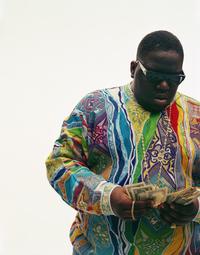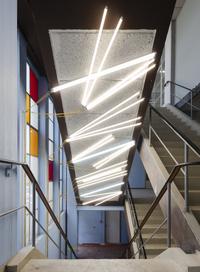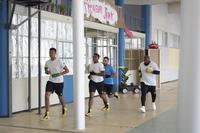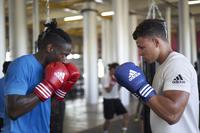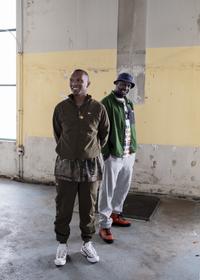‘We had never done this before, a guest-curatorship, working so closely with an arts programme. That was exactly our reason to say yes: we are forever on the hunt for something new. The two of us started out together behind a sneaker store counter, from there we set up our own outlet, which then grew into a kind of cultural platform – we’re always looking to expand our boundaries. And, of course, through the years we’ve met countless artists and performers. Chapter 1NE is our way of showcasing this. All our interests and fascinations. It’s all interlinked, because it all comes from the same cultural hothouse.’
Speaking is Guillaume ‘Gee’ Schmidt. He talks calmly, thoughtfully, and seems to have considered every answer before I’ve even asked the question. His partner in crime Edson Sabajo is still on his way. It’s unclear what’s keeping him. Gee checks his phone twice. ‘I texted, but I don’t know where he is; he’s coming straight from the airport, but I have to leave again soon, so let’s just continue.’
When asked about the ‘hothouse’ he just referred to, he immediately lights up. ‘Hip-hop, of course. That’s really the essence for me – and for Edson too – for years now we’ve been using hip-hop as a tool to get to know all sorts of different people and relate to the outside world. I’m talking about hip-hop in the broadest sense of the word: a culture that’s much more than just music. Often if someone’s heard Eminem they assume they know what hip-hop is, but hip-hop’s about a lot more. It stands for originality, for not being stereotyped, for movement, for ingenuity, for collective discovery, for sampling, in other words, borrowing bits and pieces, and transforming them into something new. This entire exhibition is about that.’
Gee continues to explain that, despite these hip-hop roots, this isn’t to say that he and Edson have chosen a collage of rappers or classic hip-hop elements such as graffiti. ‘We could have; we could have worked exclusively with black artists to make a statement, but that’s not what we wanted. We’re looking to combine extremities you hadn’t seen coming.’
As an example of such extremes, he refers to the visual artists Neo Matloga and Erik van Lieshout. ‘I wouldn’t necessarily think to place them within hip-hop, but I think they’re both really dope. Take Van Lieshout: his work is so meticulous, full of humour – it got me really excited, Edson too. That’s exactly what it’s all about for us; making this exhibition has been a real adventure, drawing from endless discussions between ourselves and with Het HEM. Talking about what we like and why, whereby we kept stumbling across new ideas. Our key criteria: we both had to be really passionate about it, that way everything comes together naturally.’
Edson arrives. ‘Sorry, faster just wasn’t possible. All good here?’ He first needs to smoke a cigarette, he then takes a seat at the table. Big smile, open expression. There’s a gold ring on almost every finger. He immediately starts talking while simultaneously scratching and writing in his diary. This continues throughout the conversation. ‘We always work from what captivates us, what’s keeping us busy. Our characters also really complement one another; of course, we’ve also known each other for an eternity.’
The boxing clinic emerged from Edson’s love for sport. ‘How cool is that?’ he says. ‘Already during the first meeting with Het HEM, I had talked about how important sport is to me. Football, running. They then came with Michèle Aboro, a multiple world champion boxer, currently based in Shanghai. We met up and immediately hit the same vibe. The clinic grew from there, which, rather than focusing on the sports themselves, really works with the mental aspects they call upon.
Gee nods: ‘Really dope.’
Edson: ‘Sport’s an incredibly important outlet. Your brain functions better, you’re quicker and more direct. I’m hoping the clinic also attracts young people. There’s little interest in art for a lot of kids, it’s too far removed from their world, there’s also hardly ever anything to be seen from people of colour within the museum context. And if there’s an art event from or for people of colour, it’s usually about exactly that fact. We didn’t want that. All sorts of different people from different backgrounds have participated in the making of this exhibition, from England, Suriname, Iran, all over; we want to avoid expressing a singular perspective of art or the world.’
The exhibition has certainly become political, emphasises Gee. ‘That’s, of course, readily the case when two black boys make an exhibition together – truth is, this is a super white world. And we’re both politically minded. But political in a non-emphatic way: we don’t want to push a conviction or opinion down anyone’s throat. Yes, we have Adrian Piper, yes, we have Terence Nance: both have clear political positions within their work, but we haven’t made this explicit in the curation of the show and chose to combine them with less politically-charged pieces. We’re also really doers, rather than constantly weighing everything up. Also, racism or racial inequality doesn’t play a daily role in our lives. We, of course, see that it’s there, and we certainly don’t turn away from it, but ultimately we’re going to fight against racism in a way that suits us. With an exhibition like this one, we’re essentially striving for a certain norm, that’s our objective: that we get to the point where it’s seen as normal for two boys like us to put together an exhibition. And that it’s about the content.’
Edson: ‘It’s also just about quality, that’s been our guiding principle throughout this and the best approach, in my opinion: if visitors open themselves up to this exhibition and see how incredible art can be, how varied and yet interconnected, they’ll hopefully be moved by the experience. Ultimately it’s always about sharing, that’s an essential part of hip-hop culture.’ He pauses for a moment. ‘That’s why the James Brown motto fits so well, we knew that as soon as we heard it: “You can’t be greedy. You’ve got to take some... and leave some.” ’
Gee automatically picks up the thread again: ‘Also thanks to the fact that Het HEM is so vast, we could pack a huge range in, all in one place. People we’ve had our eye on or collaborated with for years, people we’ve met through Het HEM, people we’re good friends with. It’s a medley all coming from the same source.’
Edson: ‘Seriously, for me, this is really hip-hop.’ He leans slightly toward me. ‘Hip-hop is today’s largest universal religion.’
